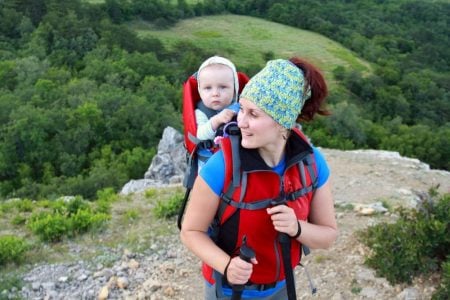Exercising with a baby carrier is a great way to burn some calories without any need for a babysitter. It’s also a good alternative in the winter when you can’t always get out and walk with the stroller.
But how are you supposed to exercise with a baby strapped to you? Is that even safe?
In this article, we’ll talk about getting back in shape postpartum and how to use a baby carrier safely. We’ll also go over five great babywearing workouts to get you back on the right track.
Key Takeaways
- Always get the okay from your doctor/midwife before getting back into an exercise routine postpartum. Give yourself and your body time to recover after birth.
- Most doctors recommend waiting at least six weeks after birth before exercising again; eight weeks if you had a C-section. Listen to your doctor, and don’t jump in too soon.
- It’s also important to start slowly. Gradually increase the length of cardio and the amount of resistance training. Listen to your body, and don’t push yourself too hard.
- Benefits of exercising with your baby include fitting in your fit time, bonding time, helping baby’s development, and creating a healthy family habit.
When To Exercise Postpartum
Always get the okay from your doctor/midwife before getting back into an exercise routine. Give yourself and your body time to recover after birth.
Take Note
It’s also important to start slowly. Gradually increase the length of cardio and the amount of resistance training. Listen to your body, and don’t push yourself too hard.
Give yourself some grace. Don’t be in a rush. Remember, it took nine months to grow that belly, and it will take just as many, if not more, to get it back in shape.
Note
Give your abdominal muscles time to heal before engaging in these activities.
Benefits of Exercising With Your Baby
Here are four benefits of babywearing exercises.
- Fitting in your fit time: You won’t have to set aside time to go to the gym or hire a sitter with babywearing. Plus, you can work out anytime and anywhere with a baby carrier or babywearing shirt.
- Bonding time: Working out with your baby in tow will give you quality bonding time. They’ll love the movement, and you can make it even more fun by singing songs and making funny faces.
- Helps baby’s development: Exercising with your baby can improve their muscular strength and motor skills.
- Creates a healthy family habit: Not only will you feel healthier, but your baby will also see how important exercise is and how it should be a normal part of daily life.
Exercising Safely While Babywearing
Every baby carrier is different, and each will have its own safety guidelines, but here are five basic safety rules to follow with any baby carrier.
Keep Baby’s Airways Open
You should be able to see your baby’s face at all times while in the carrier. Tip their chin up, and turn their head to the side. The carrier should be tight enough to support them fully but not so tight that it restricts your baby’s breathing (2).
Position Your Baby Properly
Your baby’s head should rest on your chest, and you should be able to kiss them. Do not place them too low or too high in the carrier. Your baby’s legs should be positioned like a frog with their knees higher than their bottom. Avoid any carriers where their legs would dangle straight down, as these do not promote healthy hip and spine development and could lead to infant hip dysplasia (3).
Practice!
When trying out new carriers, always have a spotter to help you, or practice close to the ground over a soft surface, like a bed.
Check Your Carrier for Wear
Be sure to check your carrier for wear, tears, or any other damage before every use.
Follow the Manufacturers’ Instructions
Before using your carrier, know the weight and height limits and how to put it on and position your baby properly. Read the instructions to know at what age, weight, and height your baby can switch positions.
Five Babywearing Exercises To Try
There are many exercises you can do with your baby in a carrier. They range from cardio to body resistance to using light weights. Below are five babywearing workouts to get you back in shape.
1. Yoga Restorative Floor Practice
- Difficulty level: Easy.
- Length: 20 minutes.
- Equipment needed: A baby carrier, an open space, a yoga mat, and a yoga strap (a belt, scarf, or rope will also work).
- Type of workout: Restorative yoga practice, including strengthening and stretching, awareness, controlled breathing, and mental restoration.
- Workout summary: This gentle yoga practice helps stretch and strengthen your arms, obliques, shoulders, and hamstrings. It relieves lower back pain and calms your mind. I like to do this practice whenever I’m feeling stressed or anxious, to help relieve some tension. It helps me focus on my breathing and opens my body.
2. Low-Impact Cardio Workout
- Difficulty level: Medium.
- Length: 20 minutes.
- Equipment needed: A baby carrier and an open space.
- Type of workout: Low-impact cardio — works the legs and core. It includes walking in place, lunges, side climbers, side-to-side stepping, hamstring curls, and gently twisting and stretching.
- Workout summary: This workout will bring your heart rate up and get you sweating. You’ll really feel it in your legs! We enjoy this workout because it gives us a feeling of accomplishment and burns off the baby weight, without being too intense. Plus, the constant moving and bouncing are great for getting baby to sleep.
3. CariFit Post-Natal Workout
- Difficulty level: Medium.
- Length: 15 minutes.
- Equipment needed: A baby carrier and an open space.
- Type of workout: This workout is specifically geared toward postpartum women. It engages the whole body and includes cardio, strengthening, stretching, and balancing. It includes exercises such as squats, hamstring curls, lunges, and standing side crunches.
- Workout summary: It’s great for toning your postpartum body. With a warm-up, cool down, and 20-second breaks to get a drink, catch your breath, or interact with your baby, it’s perfect for new mamas. We love that Cari, the instructor, goes over what good form should look like and reminds you to breathe correctly.
4. Total Body Workout
- Difficulty level: Medium.
- Length: ~20 minutes.
- Equipment needed: A soft structured carrier, an open space, dumbbells (5-12 pounds), a sturdy bench or chair, and a resistance band (optional).
- Type of workout: This is a whole-body workout focused on strengthening. You will complete three sets of each superset and 10-15 reps of each exercise (all of which are listed in the description under the video). Exercises include dumbbell deadlifts, curl to press, walking lunges, dumbbell rows, squat to kickback, dips, crunches, toe touches, and planks. The core exercises are done without your baby in the carrier.
- Workout summary: With this workout, you’ll really feel the burn in your legs, arms, and core. It’s all about building and toning your muscles, which also increases your metabolism and burns off the baby weight. We love this workout because it includes abdominal exercises, dips, and planks.
5. Babywearing Dance Class
- Difficulty level: Easy.
- Length: 4 minutes.
- Equipment needed: A baby carrier and an open space (hat and sunglasses are optional).
- Type of workout: Dance, cardio.
- Workout summary: So, this workout is truly a lot of fun. GroovaRoo has many babywearing dancing YouTube videos, but this is one of our favorites. You could do as many dances as you’d like for a single workout. It’s fun to learn the moves, burn some calories, get your heart rate up, and entertain your baby.






